
- Episode.8 「世界で評価される馬革専業タンナー『新喜皮革』」
- Episode.7 「ロマンと科学で紡ぐ”XX”の遺伝子 Vol.4」
- Episode.6 「ロマンと科学で紡ぐ”XX”の遺伝子 Vol.3」
- Episode. 5: The DNA of “XX,” Interwoven with a Spirit of Adventure and Science – Vol. 2
- Episode.5 「ロマンと科学で紡ぐ"XX"の遺伝子 Vol.2」
- Episode.4 Starting “XX” Reproducing Project. Vol.1
- Episode.4 「ロマンと科学で紡ぐ"XX"の遺伝子 Vol.1」
- Episode. 3 Vintage Wool Blanket Making Revives in Modern Times Vol. 3
- Episode.3 「現代に蘇るヴィンテージウール Vol.3」
- Episode.2 Vintage Wool Blanket Making Revives in Modern Times Vol. 2
- Episode.2 「現代に蘇るヴィンテージウール Vol.2」
- Episode.1 Vintage Wool Blanket Making Revives in Modern Times Vol. 1
- Episode.1 「現代に蘇るヴィンテージウール Vol.1」
Episode.4 Starting “XX” Reproducing Project. Vol.1
~Episode 1 Starting “XX” Reproducing Project.~“501XX” Needless to say, it's a legend in men's fashion.
Despite the fact that the product quality and the meaning of the existence have been handed down for more than half a century, there are still many mysterious parts existing.
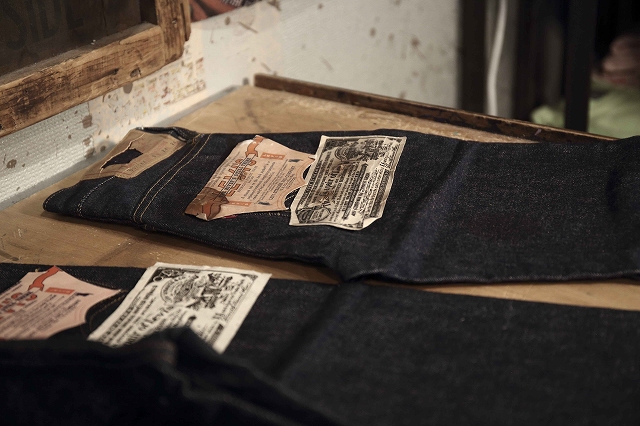
This project is to literally put a scalpel into dead stock 501XX manufactured in '53 -54, and utilize the latest modern science and the outstanding experience of denim craftsmen to unravel those mysteries as much as possible. The goal is to produce jeans close to brand new 501XX at the time as much as possible.
This project is made of three episodes.
The focuses of the first episode are three, the original attraction of 501XX, the difficulty of reviving 501XX to the present day, and why JELADO has started such a project now.
Check out the conversation between JELADO Goto (Goto) and craftsman Mr. Muroi (Muroi), the pilot of the project, who has been pursuing the modern reproduction of 501XX for more than 20 years, and has continued to feed back the knowledge to the domestic denim industry.
“No correct answer. That’s the attraction of 501XX”- Muroi
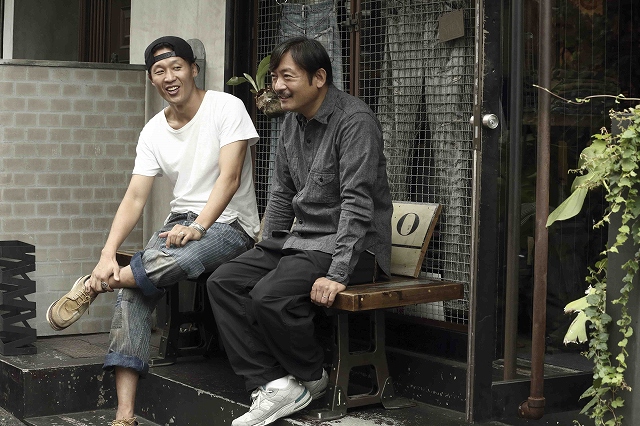
Goto: First of all, I think that people from various generations would see this article, so I illustrated what “501XX” is in this project.
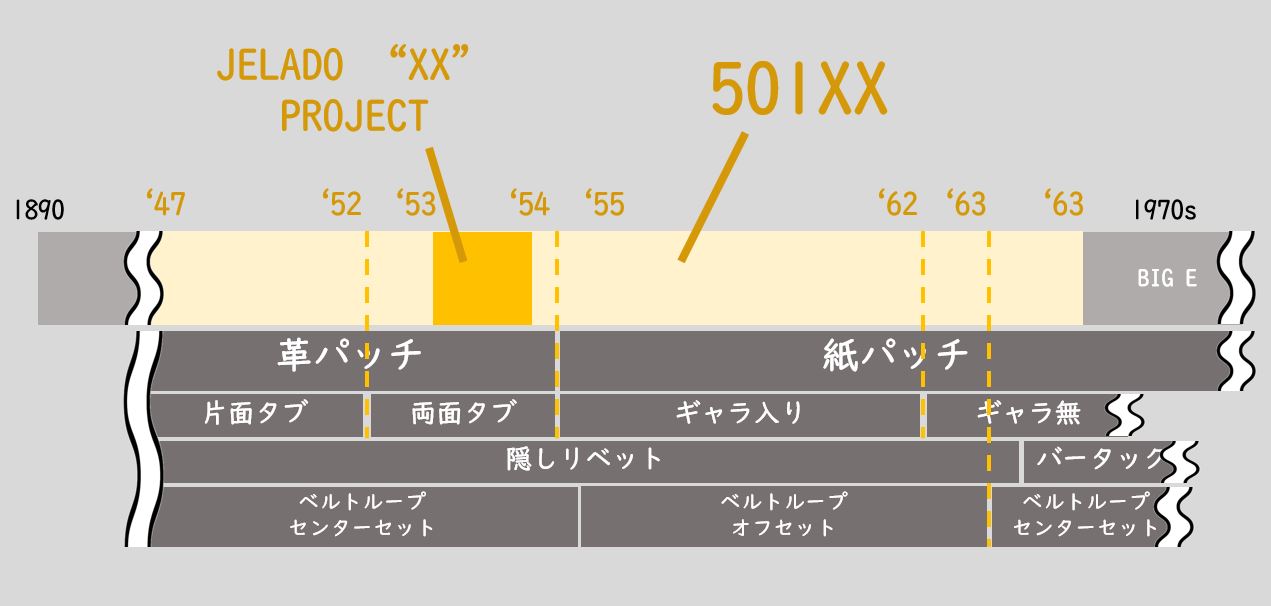
At JELADO, we set 1954 as the year when 501XX has reached the final form, and have been making 5 pocket jeans called “55 model” for a long time. The numbers are taken from the last two digits of 1955, the year its model seemed to have completely been spread to the market.
I thinking of proceeding this plan as renewing the “55 model”.
Well, I’d like to go straight to the main topic, but from the perspective of Mr. Muroi who has seen the denim industry in Japan, which boasts the highest reproduction quality of 501XX in the world standard, for more than 20 years, to get straight to the point, what is the attraction of 501XX?
Muroi: After all, the best answer is that it is the final form of 5-pocket jeans as work clothes and is the origin of modern men's casual fashion. Even major Maison brand designers around the world are still chasing 501XX in the field of 5-pocket jeans.
Goto: It’s the roots of men's casual fashion. That’s it.
It's no exaggeration to say that it's the synonym for vintage denim.
Let me change the question direction a bit. What do you think about the attraction in terms of the quality of the product seen by as a “denim craftsmen”?
Muroi: Since my specialty is mainly fabrics, when I mention the fabric first, the balance as tough work clothes is excellent even from the perspective of us who is living today.
The detailed numbers are a confidential, so I can’t talk about them here, but in addition to being particular about the number of yarn per inch and No., if you look at the model, which is the base for this project, manufactured around '53 -54, you should be able to understand that the characteristics of each cotton are differently used for warp and weft.
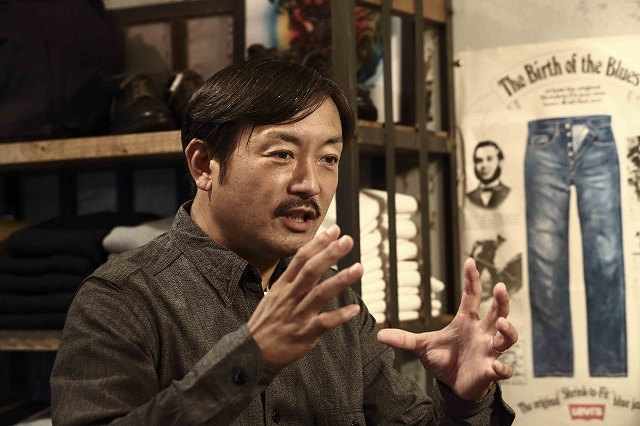
Goto: Is it still different from other brand products of the same generation?
Muroi: Yes, it’s different.
Levi’s seems to have taken measures to improve the quality at a high frequency and you can see minor changes in specifications of individuals of the same age, and I can see their sincere attitude towards manufacturing. Compared to other brands, as a company, the history and scale were overwhelmingly large, the fact that they were fully committed to the work wear manufacturing business, and everything was made in their own factory. Therefore, I think that the fact that they can quickly reflect on-site workers’ voices in their products created a big difference as the result.
Goto: I see. There is a famous episode that when the so-called “WWII model” was manufactured under the control of supplies during World War II before 47 model, they increased the number of fabric ounces to avoid quality degradation against the instructions of the authorities, so the stance of committing to quality was very strong. By the way, if they were changing the detailed specifications, is it possible to define a physical definition of 501XX or a technical definition as a product?
Muroi: That's a difficult question (laughs)
At that time, the standard of their quality control was lower than that of the present age, and there were considerable differences in the shape of the yarn in the lot and the indigo color, so there is no one called 501XX.
While there are differences in cotton, machinery, and dyes depending on each era or lot, if you decide the base individual, it is possible to make a thing that is as close as possible to the individual. However, in such cases, I think selecting what to make is very important.
That’s why I'm really looking forward to this project.
Because 501XX in dead stock is cut up into pieces and analyzed.
Goto: The more you know, the deeper 501XX is.
There seems to be an answer, but I think there seems to be no answer.
Muroi: That's right.
Because there’s no right answer, it’s interesting for a craftsman like us, that’s why I could think I can get along with it for my entire lifetime. (laughs).
"What is the root of the greatness of Japanese denim?" – Goto
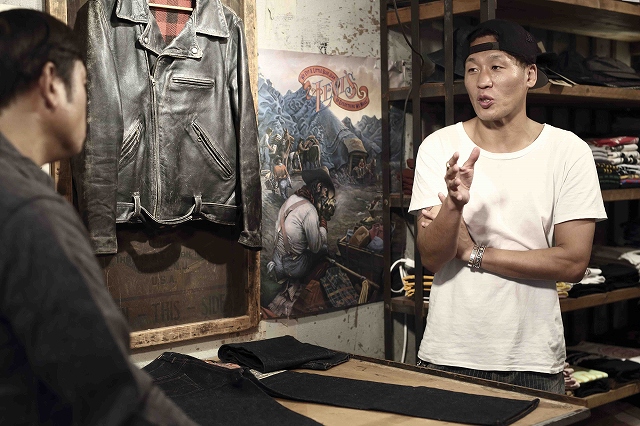
Goto: I think that the world of denim craftsmen reproducing something like 501XX without any clear correct answer must be very tough, but what is the most difficult part in polishing craftsman's skill?
Muroi: The most important thing is to keep your inquiring mind.
This become a bit conceptual talk, but it's very important to always keep on adopting new knowledge without having common sense.
Because even if you use the latest technology to analyze the fabric, there are cases that the analyzed part of the fabric or the fabric itself is an “exception”, so work that fixes those gaps with using knowledges of objective facts and experiences is required sometimes.
Goto: Although technologies are useful for collecting objective facts, with reproducing 501XX, overwhelming knowledge and experience are required for the direction and data analysis. Is that, right?
Muroi: That's right.
A little while ago, there were 5-pocket jeans that 501XX was reproduced in some oversea country by using modern science, but the color looked like a bad liver ... (laughs)
After all, I felt again that 501XX is something that can't be beaten by science alone.
The road to reproduce 501XX is a series of ad-libs that only experienced people can do.
Goto: This is a little bit rough question, but where is the high quality of made-in-Japan denim come from?
Muroi: The first reason is the length of the history of “I like 501XX” of the craftsmen.
In my case, I like the fabric of 501XX strictly. (lough)
Also, advantages when compared to overseas is that the dyeing technique is one of them, but the loom we use is the most difference.
I think that only Japan can use the shuttle loom that weaved denim fabric in the United States in the 40’s and 50’s.
In addition, it takes 10 to 20 years to be able to handle the shuttle loom properly, so it can be an advantage to have craftsmen who can handle it.
“Today, I will cut the dead stock with scissors.” — Goto
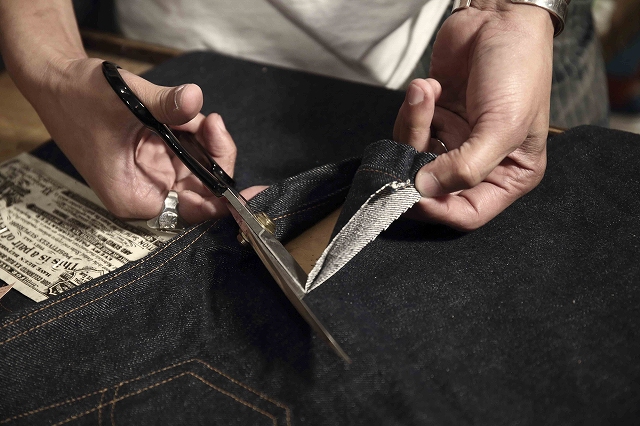
Muroi: By the way, why did you decide to do this project now?
Goto: To say it simply, I wanted to reproduce 501XX with the realistic logic seen by JELADO as a brand.
I personally like old clothes and entered this industry, so I've considerably seen the real things with my eyes.
And because users a little while ago had something close to this feeling, without speaking anything, if there is the keyword, 501XX, I think it gave a product a topicality.
But now it is different.
I think that some kind of blind 501XX deification is progressing, so it is becoming harder to understand what is actually good in the industry.
Muroi: The number of people who have never seen actual 501XX in this world has increased, and the “501XX theory” created by the ancestors of Japanese domestic brands is not impossible to be developed horizontally to craft things now ...
Goto: Yes, that's why I was particular about the first material, that is, the dead stock, and in this era, by crossing the latest cutting-edge technology with Muroi-san’s experience, I’d like to create an “answer” as JELADO and release it to the world.
I think passing down the attractions of 501XX to future generations is one of the responsibilities of a brand that has been fascinated by 501XX and continues to run today.
So today, in order to have a research institution analyze the dead stock 501XX fabric, I will actually cut the jeans with scissors and have Mr. Muroi take the fabric home. (laugh)
Muroi: Oh, you’re doing it here and now. (laugh)
Goto: Let’s cut it off. (laugh)
Muroi: I will bring this to a research institution to analyze the No., number of twists, number of counts, woven structure, fiber tone, and dye density.
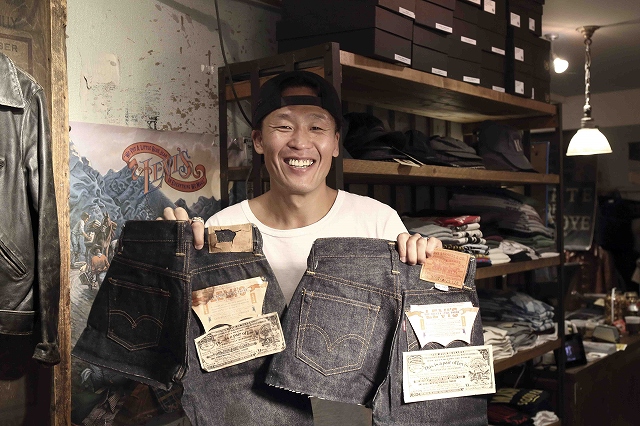
Preview of Next Episode
Next time, we will follow the process of actually reproducing the fabric with the scientific analysis results of the dead stock 501XX. Look forward to it!
<Writer/Covo Tagata Photographer/Seiji Sawada>














